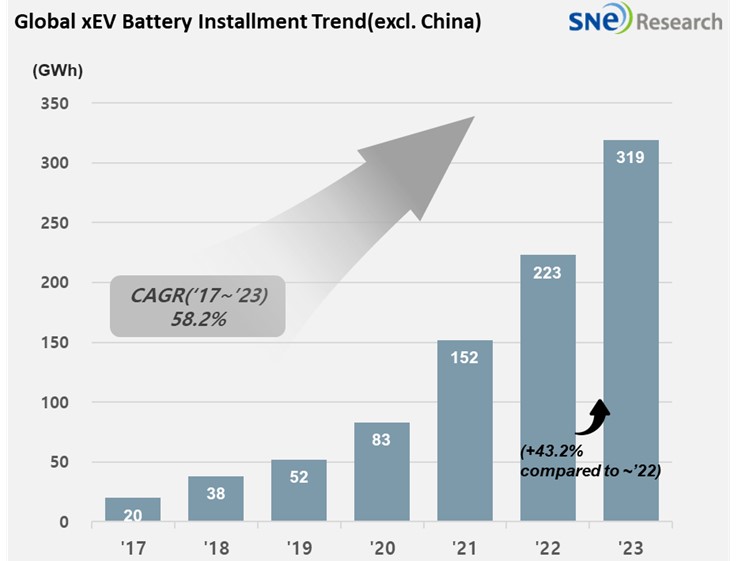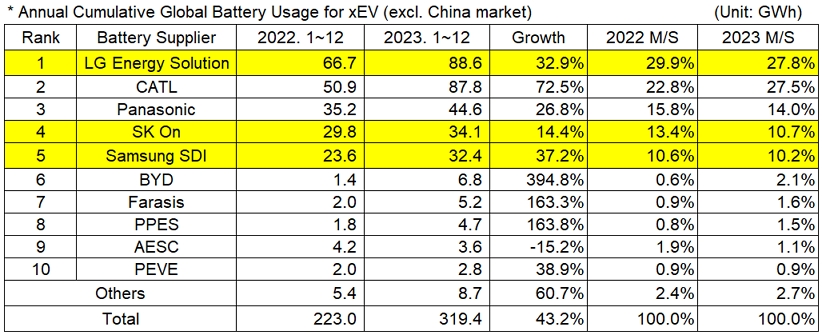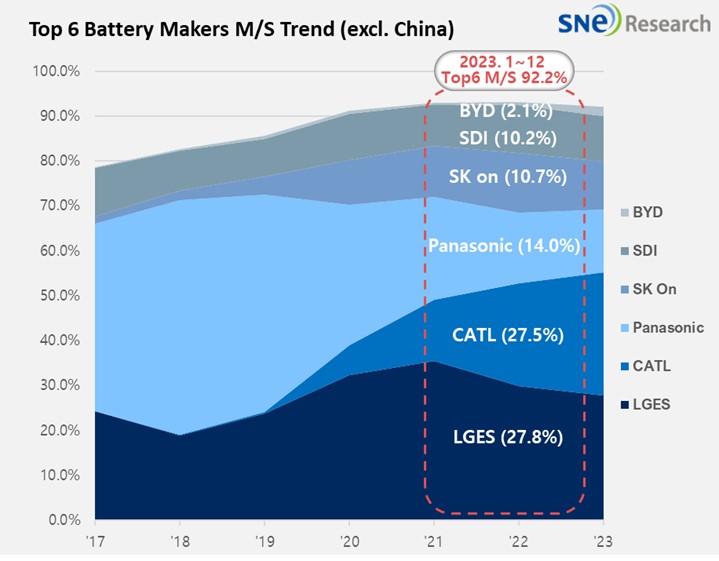From Jan to Dec in 2023, Non-Chinese Global[1] EV Battery Usage[2] Posted 319.4GWh, a 43.2% YoY Growth
- K-trio took up 48.6% M/S from Jan to Dec
Battery installation for
global electric vehicles (EV, PHEV, HEV) excluding the Chinese market sold from
January to December in 2023 was approx. 319.4GWh, a 43.2% YoY growth.

(Source: Global EV and Battery Monthly Tracker – Jan 2024, SNE Research)
In the ranking of battery usage for electric vehicles, the K-trio battery makers all ranked within the top 5. LG Energy Solution kept the top position with a 32.9% (88.6GWh) YoY growth. SK On took the 4th position with a 14.4% (34.1GWh) growth, while Samsung SDI ranked 5th with a 37.2% (32.4GWh). CATL from China have been continuously threatening the leading company based on a high growth momentum with a 72.5% (87.8GWh) growth.

(Source: Global EV and Battery Monthly Tracker – Jan 2024, SNE Research)
The combined shares of K-trio recorded 48.6%, a 5.3%p YoY decline, but the overall battery usage was in an upward trend. Their growth was mainly affected by favorable sales of electric vehicle models equipped with batteries of each company. Samsung SDI continued to be in a growth trend based on the increasing sales of BMW i4/iX and Audi Q8 e-Tron as well as decent sales of Rivian R1T/R1S and FIAT 500. SK On also recorded growth thanks to solid sales of Hyundai IONIQ 5, KIA EV6, Mercedes EQA/B, and Ford F-150 Lightning. LG Energy Solution. LG Energy Solution posted the highest growth among the K-trio, propped up with favorable sales of Tesla Model 3/Y, VW ID. Series, and Ford Mustang Mach-E that are highly popular in Europe and North America.
Panasonic registered the battery usage of 44.6GWh in 2023, a 26.8% compared to the same period of last year. Panasonic, one of the major battery suppliers to Tesla, has most of it battery usage installed in Tesla Y in the North American market. As Panasonic has been reported to launch advanced 2170 and 4680 cells, it is expected to expand it market share mostly focusing on Tesla.
The Chinese battery makers, including CATL, have been rapidly expanding their market shares in the global market, showing a higher growth in the non-China market than in the domestic market of China. CATL’s battery is installed to Tesla Model 3/Y (made in China and exported to Europe, North America, and Asia) as well as vehicles made by major OEMs such as BMW, MG, Mercedes, and Volvo. Recently, CATL’s battery is installed to the new KONA model by Hyundai and KIA Ray EV model, meaning that the Chinese battery makers’ influence has been gradually expanding in the Korean market.

(Source: Global EV and Battery Monthly Tracker – Jan 2024, SNE Research)
As it has become obvious that the global EV market experienced a slowdown in demand throughout the year of 2023, the battery industry has received a repercussion effect. Some of reasons for such a sluggish demand growth in the EV market are as follows: early adopters sated with electric vehicles; economic slump due to the continuation of high interest rates and high price; and shortage of charging infrastructure. While a slowdown in the EV market is forecasted to linger for a while, there are more factors that may have negative influences on electric vehicle demand; one, tightened regulations on the IRA EV subsidy may narrow the scope of EV models eligible for tax credit; two, uncertainties are prevalent about whether such tax credit may exist even after the US Presidential election scheduled at the end of 2024. As OEMs are expected to go through a tougher competition for price reduction to survive from the price-focused EV market, attentions should be drawn to what type of strategies that the Korean battery makers would take in order to develop their competitive edge in battery technology and secure stable supply chains of key battery materials.
[2] Based on battery installation for xEV registered during the relevant period.

